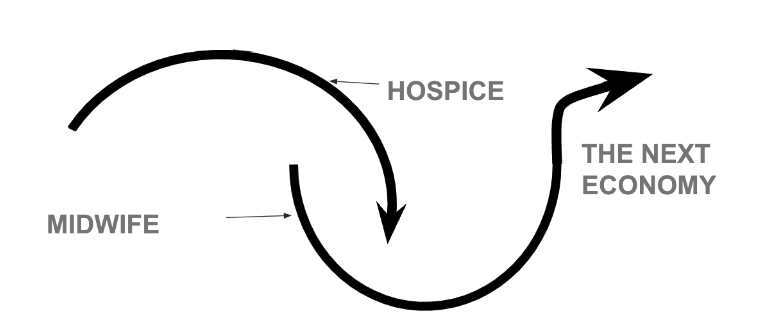
cross-posted from Shareable
The Business As Usual (BAU) economy has deep-seated and systemic problems. Before addressing how to make a transition to the Next Economy, it is important to understand these problems so that it is clear why this transition is needed in the first place. Here are some of the most critical problems:
Problem 1: Interest-bearing Debt
An increasing percentage of people use money to meet their basic needs. This is problematic because money is most often generated through interest-bearing debt, meaning it is created through the process of being lent out. For example, if you take out a loan, the bank deposits money—which it created out of thin air—into your account and begins charging you interest. One consequence of this is that it generates an artificial need for growth—often via activities that exploit people and the planet—in order to generate enough money to repay the debt and interest. This burden of continual growth has placed extreme pressure on society and the environment. Many people feel forced to participate in this system because they do not have access to alternative strategies that can meet their needs at a lower cost to their mental, emotional, physical, and spiritual health. It is also problematic because it depersonalizes interactions—the opposite of how human needs have historically been met through gifts, bartering, and sharing. You end up with impersonal transactions rather than relationships. You get business instead of community.
Problem 2: A Scarcity Mindset
In Oakland, California, houselessness is a huge challenge (“houseless” and “unhoused” are sometimes used in place of the word “homeless” because many unhoused people feel that they do have homes). Tents and other makeshift structures can be seen under highway overpasses, in industrial areas, and on downtown city streets. In 2022, there were 5,055 houseless people—a 24 percent increase over the previous three years. However, the most recent U.S. census data for the area showed that more than 15,500 housing units remain vacant in Oakland. This shows that there are three times as many vacant houses as houseless people. Similarly, as was mentioned in the Introduction, about 800 million people go hungry or malnourished each day, even though twice the number of calories to feed all of humanity are produced. Scarcity is a fundamental concept of the BAU economy. Often, as in the case of housing and food, resources may be generally plentiful but distributed in a way that generates scarcity among certain population segments.
Problem 3: The Fallacy of the Meritocratic Society
Meritocracy is a political system in which economic benefits and political power are vested in individual people based on talent, effort, and achievement rather than wealth or social class. We want to call out (in order to hopefully disrupt) that meritocracy is a narrative that has been explicitly championed around the globe to distract from the recognition that colonialism, white supremacy, capitalism, and patriarchy are some of the reasons why inequities exist. It is much easier to keep the power structures in play when folks are directing their attention at individual performance instead of changing the oppressive systems that sustain inequality.
Problem 4: The Fallacy of Progress
The fallacy of progress occurs when generalized economic statistics are put forward as proof that humanity is trending toward the growth of well-being and prosperity. Using a single economic measurement like gross domestic product (GDP) to quantify progress for all humanity does not tell the whole story. We do not use GDP to measure progress in this book and our live training. For example, in an oil spill, well-being and environmental health go down (people who fish out of work, ecosystem collapse, etc.) while GDP may actually increase (through the transactions and expense of clean-up efforts, increased extraction elsewhere, even relief spending). This makes GDP a questionable measurement of “progress.” We prefer to reference health and well-being measures, such as the genuine progress indicator (GPI). GPI shows that on a global level, factoring in negative impacts that are not quantified by GDP (including species die-off, overwhelming toxics load, and institutionally enforced incarceration), wellbeing has declined over the past several decades.
Problem 5: …and Beyond
There are so many more problems. Property ownership, intellectual property silos, the pressure to maximize shareholder earnings, extractive investment culture, short-term thinking, structural racism, structural sexism, and externalizing social and environmental harm must be addressed. The challenges society faces expand beyond the boundaries of what is traditionally thought of as economy to include the education system, the media system, how humans collectively make sense of information, how to make decisions together, what is valued, and how people live.
Getting from Here to There: Transition Frameworks
Now that we have established a shared language, a vision for the Next Economy, and an analysis and critique of the BAU economy, it can be helpful to offer some frameworks to support humanity’s journey from the problems and challenges of the current economy and systems to the Next Economy. The journey can appear long or impossible. It can be difficult to discern what actions to take and which strategies matter. A natural and understandable response to the harms of the BAU economy is to recoil from the pain and grief, to freeze and deny that change is needed, and to filter out information that urgently suggests otherwise.
We have found the Two Loops model developed by the Berkana Institute very useful for making sense of the variety of approaches and paths on the journey to transforming the economic system (indeed, the image on the cover of this book is inspired by that work). The Two Loops model can also help you better understand what role you might play in supporting the transformation. While we are inspired by the Berkana Institute’s work and want to ensure that all credit for the creation of this model is given to them, for the purposes of our work we emphasize different aspects and interpretations of the Two Loops idea. We encourage you to learn more about how the Berkana Institute uses the model on their website at berkana.org.

Source: Lift Economy, adapted from the original Two Loops model developed by the Berkana Institute
The Two Loops model is useful for helping understand the transition from a dominant, old system (BAU economy) to an emergent one (Next Economy) and how to partner with the natural force of evolution to transition to the new and more adaptive system. The model itself is a simple drawing of two curves or loops (Figure 1). The “hospice” curve descends, representing the gradual “death” (or deep transformation or composting) of the existing system (in our case, the BAU economy). The “midwife” curve starts under the hospice curve and moves up, representing the birth or emergence of a new system. Together they represent the journey from now to the full realization of the Next Economy. What does it mean to do hospice and/or midwifery work to transition the economy?
- Hospice: Some people, when they become aware of the harms and injustices of the BAU economy, begin to work within (or adjacent to) the existing system, structures, and norms to reduce the harm of the BAU economy, taking incremental actions. Examples include activists pressuring Walmart to commit to 100 percent renewable energy by 2035, or getting Unilever to agree to reduce the amount of waste from its products that end up in the landfill, or the years-long effort that has gone into getting investment firms like Goldman Sachs to launch environmental, social, and governance (ESG) public equity investment funds, or campaigns to get Adidas to replace virgin polyester with recycled polyester in products. These hospice actions and strategies are necessary—but wholly inadequate—to effectuate the transition to the Next Economy. People involved in hospicing out the BAU economy can sometimes regard midwife efforts with cynicism. They might refer to midwife efforts as “impractical” because they do not immediately address the perceived problems “at scale.” Hospice work is often easier to take on at first because more resources and opportunities for personal security are available. However, hospice efforts can start to generate cognitive dissonance as it becomes clear that hospice is inadequate to effect the full transformation.
- Midwife: Others are not interested in incremental change. They want radical change to the existing systems, structures, and norms. These folks set off to midwife into existence entirely new (or novel, but informed by old-wisdom traditions) forms of organizations, efforts, and lifeways to model what the system might look like after it has already fully transformed. They are inspirational, but midwife strategies come with their own set of challenges. Midwife efforts are often fraught, under-resourced, bereft of personal security, and culturally invisible to society at large. People involved in midwife work often regard hospice work as inadequate and a distraction from the courageous path-finding work needed to truly transform the economy. Midwife workers may have few opportunities for income and feel extreme pressure to stop the harm of the BAU economy, so sometimes folks involved in more radical work feel antipathy toward anyone not fully engaged in dismantling the existing system as quickly as possible.
It is important to note that this is not a strict binary. Projects can, and often do, have both hospice and midwife elements. In addition, neither hospice work nor midwife work is “better,” “more important,” or “more impactful.” People must push firms like Adidas to reduce their environmental footprint as quickly as possible. Simultaneously, new enterprises like Soul Fire Farm—an Afro-Indigenous-centered community farm committed to uprooting racism and seeding sovereignty in the food system—need to be created to model what the Next Economy might look like.
The Two Loops model’s key insight is that hospice and midwife work is needed. We understand and empathize with any resistance you may have to the idea that hospice work and midwife work are equally important. We still grapple with this tension on the LIFT team. Like many of us, you may have developed a strong identity and attachment to the story that there is a clear binary and your type of work is better than the other. It can feel good and can reinforce your sense of self, to believe you are on the correct side of the problem. However, binary “us vs. them” thinking is part of cultural conditioning. Judging and blaming others is easier than expanding the definition of “us.” Creating a larger “us” takes vulnerability, courage, humility, and the willingness to listen.
One important insight to help you on this journey is to see hospice and midwife efforts as complementary rather than separate. For example, hospice efforts can sometimes access funding and resources for midwife efforts. Hospice efforts can bring visibility to emergent Next Economy projects. Midwife efforts can sometimes inspire organizations that are only interested in incremental change to make radical shifts. The Next Economy will be achieved more quickly if you can grow an appreciation for both approaches. Try to identify areas in which hospice and midwife efforts can be mutually supportive and beneficial.
From The Next Economy MBA: Redesigning Business for the Benefit of All Life, by LIFT Economy in association with Erin Axelrod, Kevin Bayuk, Shawn Berry, and Ryan Honeyman. Learn more at lifteconomy.com/mbabook.
Shareable is partnering with LIFT Economy to share the audio recordings from the Next Economy MBA program. Over the course of a year, we’re publishing all 25 of their trainings for everyone’s benefit. If you’re interested in learning more about their program, please visit: https://go.lifteconomy.com/nextmba

Add new comment